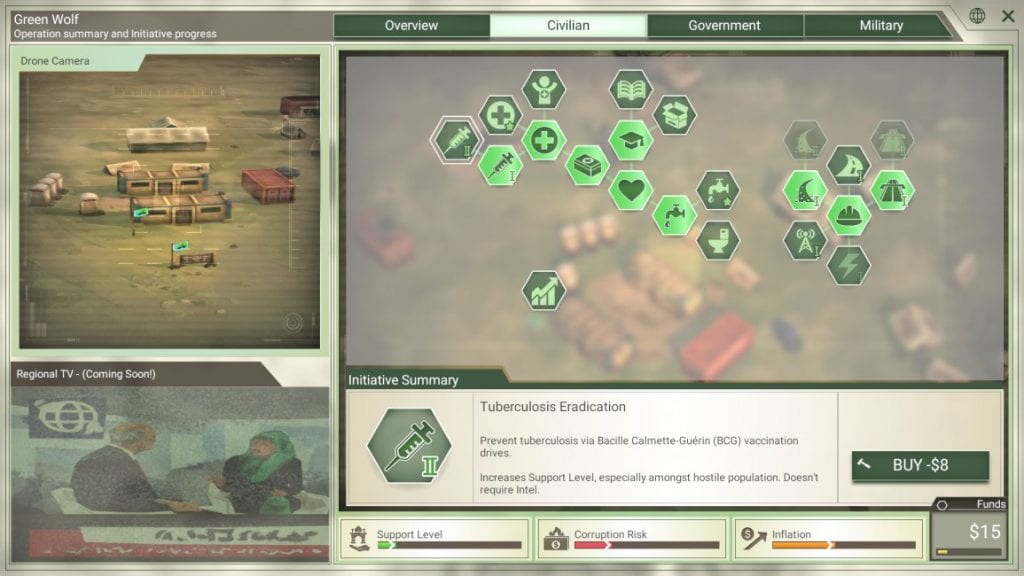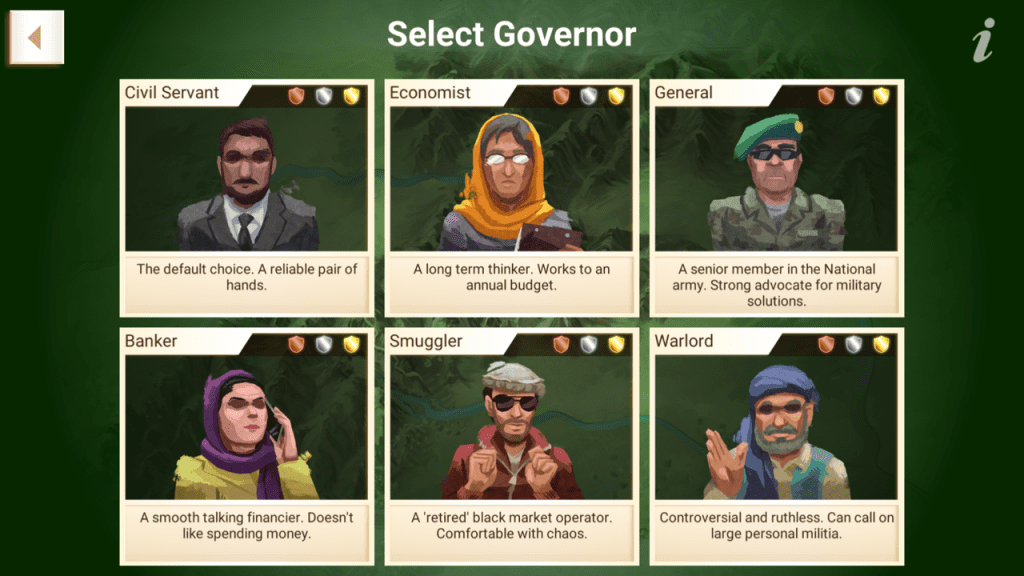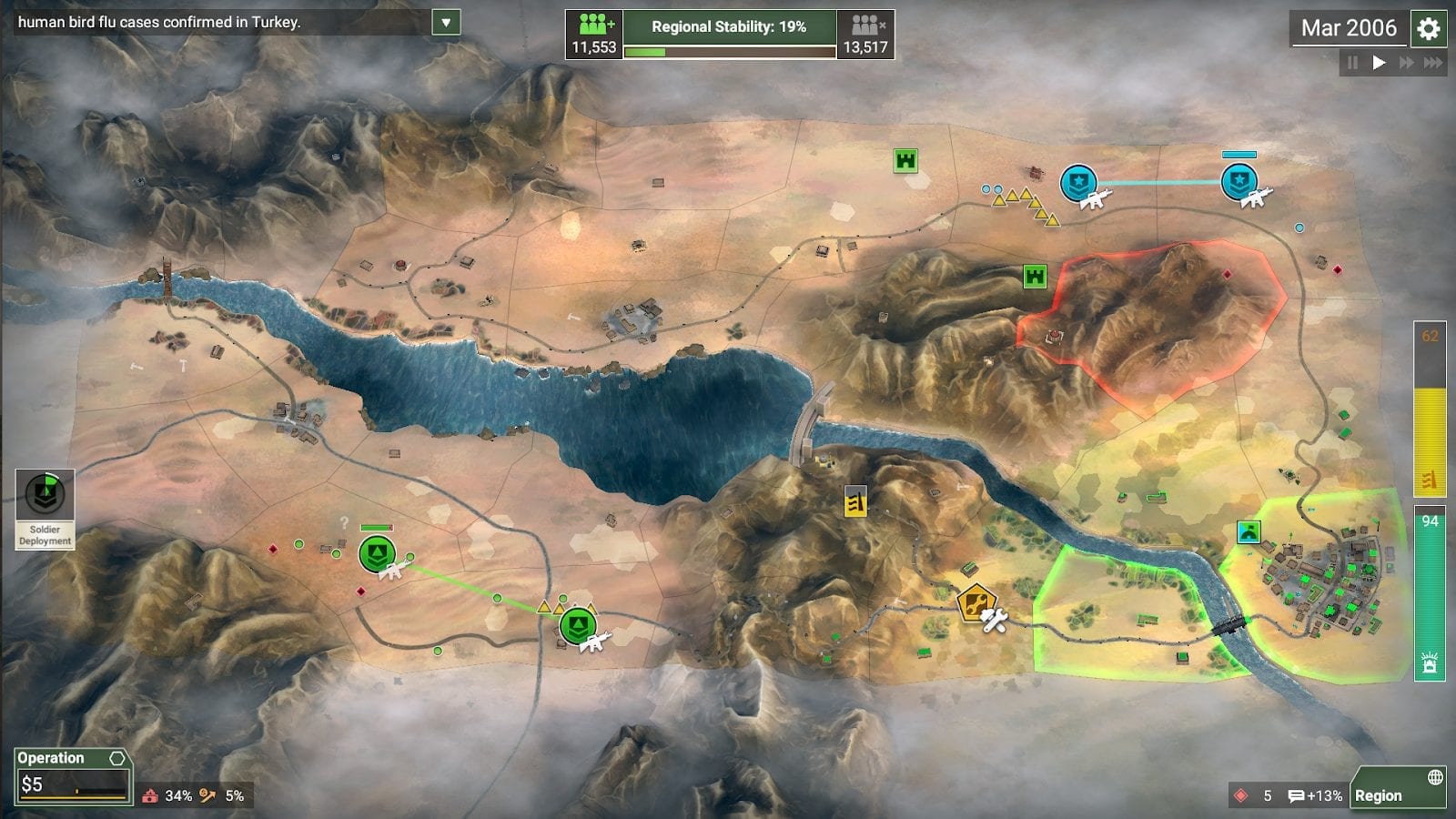Released: October 2019 (Early Access)
Rating: PEGI 7 (implied violence, mild violence)
Corruption is skyrocketing, your development programs are stalled out, the army is deserting, the Americans want to leave…and your air force just caused immense collateral damage. Again.
Welcome to Rebel Inc: Escalation, Governor.
What Is It?
Rebel Inc: Escalation is a new-ish real time strategy game from Ndemic Creations, where players take on the role of a governor charged with bringing peace to an unstable region of not-Afghanistan (it is extremely obvious that it is actually Afghanistan, just with the street names filed off). It is incredibly fun, but also ridiculously difficult.
For starters, you are overwhelmed with priorities, just like in real life. With a small budget each month, every decision is a trade-off. Job creation programs will increase support for your administration, but their benefit will be wasted without aggressive anti-corruption. Providing telecommunications goes down well, but the outlay may force you to abandon police oversight. The game also punishes you for hoarding. Spending too much in one go contributes to inflation, significantly increasing the cost of everything. Luckily, you can pause the game to consider your choices. If you couldn’t, your head might literally explode.
Another challenge from the get-go is managing your reputation, a barometer of how much international donors support you. If your reputation hits zero, the game ends. Unfortunately, losing reputation is extremely easy – corruption, inflation, lack of programs, and lack of security all cut into it. Gaining it back is very difficult, but it is possible, mainly by meeting the demands of citizens for public services.

These factors on their own would make for an engaging puzzle game. So, just as you get the hang of it, people start shooting at you. Obviously.
About a year into the game (five minutes worth of gameplay or so), an insurgency will spring up. Left unchecked, insurgents will blow up your pricey development projects and seize territory, making you lose reputation. You must fight them, or you will lose the game.
This is easier said than done. Your first military tools are Coalition Soldiers, representing NATO forces, which you can deploy rapidly to contest the insurgents. They move fast and hit like a ton of bricks. However, they are also deeply unpopular with the local population and can only remain in country for a relatively short period of time before being withdrawn.
The path to lasting victory is training National Soldiers, permanent armed forces. However, they take a year to train up, and are much worse fighters than the Coalition. You can supplement your forces with airstrikes, drone surveillance, and weapon upgrades, but doing so can mean neglecting critical civilian projects.
The military challenge is exacerbated by how annoying the insurgents are. Fighting battles with them pushes them out of a given area, but it does not destroy them. The only way to do that is to fully surround them so they have nowhere to run. This is, unsurprisingly, manpower intensive. And even when you have done that, new centres of insurgency will appear across the map. This makes military victory nearly impossible.
Where, then, is the path to success? It is through negotiations. The trick is to keep up the military pressure while building support among the population with development programs and good governance. Eventually, the insurgents will come to the table, presenting you with a series of choices on how you want the peace to look – more lenient options are more likely to continue negotiations, at the cost of reputation. Once a peace deal is signed, you win.
Why Play It?
Okay, so, that’s the game. Why should you play it?
For starters, while it is tough, it is also fair. With the right set up, you can triumph. As it is exceedingly difficult, that makes the experience all the more rewarding. Rebel Inc: Escalation was the first time I’ve straight up lost a game – not quit, not retried from saves, just played as best I could and lost – in months. It’s a bit of a bucket of ice water, but that makes for a refreshing challenge. A standard game also lasts about thirty to forty minutes, so it’s easy to work into a busy day.
Beyond being enjoyable, it’s also educational. Now, I must admit to bias here – my eleventh birthday present was a copy of US Army Field Manual 3-24: Counterinsurgency, after all – but the game provides engaging insight into the complexities of post-conflict stabilisation. It walks a neat line between emphasizing the need for security and advocating for development. The focus on achieving peace also ties in nicely; your goal is expressly not the destruction of the enemy, but the application of pressure to bring them to the table. This kind of politico-military unity is rarely found in war games.

Even better, while the core mechanics stay the same, there is a lot of replayability. You have the choice of fighting in seven different regions, each with different dynamics. For example, Saffron Fields lets you focus more on development, while Black Caves promises a grinding counterinsurgency battle. You can also unlock different Governor types to play as, each with their own unique attributes. The General, for example, gives you more powerful military options but makes civilian projects more expensive; the Smuggler thrives in environments of high corruption; and so on. Moreover, the game is in Early Access, with more features including a narrative campaign, multiplayer, and a scenario builder coming down the pipe.
In short, Rebel Inc: Escalation is a challenging game that kicks you in the face from the start and piles on the pressure from there. With plenty of replayability and educational value, it is well worth your time.
So good luck, Governor.
You’ll need it.
Final Verdict: 9/10
Words by Matthew Ader
